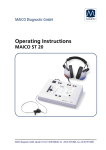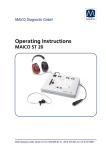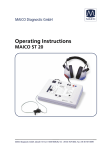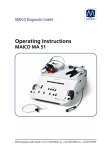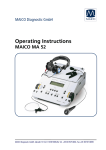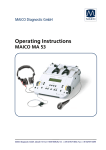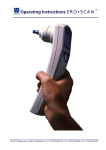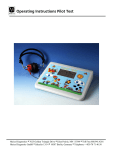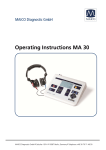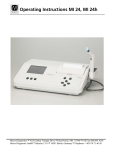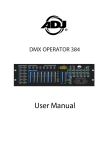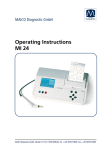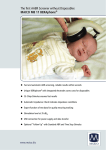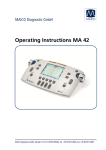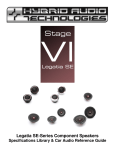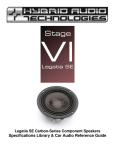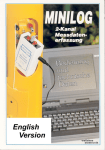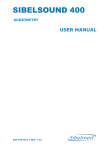Download Operating Instructions MA 50
Transcript
Operating Instructions MAICO MA 50 Operating Instructions MA 50 Table of Contents Page 1 Introduction............................................................................................... 3 2 Description ................................................................................................ 4 3 Getting started .......................................................................................... 5 3.1 Unpacking your instrument ..................................................................... 5 3.3 Getting familiar with the MA 50 ............................................................. 7 3.3.1 Using the keyboard of the MA 50 ........................................................ 8 3.3.2 The display of the MA 50 ..................................................................... 8 4 Pure tone audiometry ................................................................................ 9 4.1 Air Conduction (AC) Testing ................................................................... 9 4.2 Uncomfortable Hearing Level (UCL) Testing............................................10 4.3 Bone Conduction (BC) Testing ...............................................................11 4.4 Masking of the opposite ear ................................................................11 4.4.1 Crossover: .......................................................................................11 4.4.2 Masking theory: ..............................................................................12 4.4.3 Manual masking: ............................................................................12 4.4.4 Automatic masking: ........................................................................13 5 Quick reference guide ...............................................................................14 5.1 Startup settings .....................................................................................14 5.2 Receiver selection ..................................................................................14 5.3 Frequency selection ...............................................................................14 5.4 Warble tone (FM) ...................................................................................14 5.5 Pulse tone..............................................................................................14 5.6 Test channel selection ............................................................................14 Geba_MA50_Fe_11a.doc 1 851 406/2 11/11 Operating Instructions MA 50 5.7 Tracking function ...................................................................................14 5.8 STIM Mode selection .............................................................................15 6 Recommended literature ...........................................................................16 7 Computer interface ..................................................................................17 8 Care and maintenance of the instrument ..................................................18 9 Trouble shooting ......................................................................................19 10 Technical Data ......................................................................................20 11 Warranty, Maintenance and After-Sales Service ....................................24 12 Safety Regulations ................................................................................25 12.1 Electrical Safety: ...................................................................................25 12.2 Measuring security: ..............................................................................25 12.3 Device control: .....................................................................................25 Checklist for Subjective Audiometer Testing .................................................26 Geba_MA50_Fe_11a.doc 2 851 406/2 11/11 Operating Instructions MA 50 1 Introduction Thank you very much for purchasing a quality product from the MAICO family. This MA 50 audiometer is manufactured to meet all quality and safety requirements, and has been certified with the CE-symbol according to Medical Directive 93/42/EEC. In designing the MA 50 we placed particular importance in making it a userfriendly device, meaning its operation is simple and easy to understand. And because MA 50 functions are software controlled, upgrading later to new, extended measurement functions will be simple and inexpensive. That means that you have invested in a device that will adjust to your future needs. This user manual should make it as easy as possible for you to become familiar with the functions of the MA 50. Please open out the flap of illustrations on the last page. The description of the position (e.g. ➄) of controls, displays and connections, found again in the text, will make it easier for you to learn how to operate the MA 50. If you have problems or have ideas for further improvements, please get in touch with us. Simply call. Your MAICO-team Geba_MA50_Fe_11a.doc 3 851 406/2 11/11 Operating Instructions MA 50 2 Description The MA 50 is an audiometer for pure tone audiometric tests. It can be used for ENT diagnostics in the office, and for mobile audiometry in clinics, homes and abroad. Tests can be performed using the TDH 39 headphones (AC), B 71 bone conduction receiver (BC) or optional insert phones. Built-in test signals are pure tone, pulse tone, warble tone and narrow band noise. The MA 50 audiometer delivers 11 air conduction (AC) test frequencies from 125 Hz to 8 kHz, with levels from -10 dBHL to 120 dBHL. Bone conduction (BC) can be tested with 11 test frequencies from 125 Hz to 8 kHz with levels from -10 dBHL to 70 dB HL (with the standard bone conductor B 71 the frequency range is limited from 250 Hz to 6 kHz). The optional insert phones EAR 3A submit levels from -10 dBHL to 120 dBHL with 11 test frequencies from 125 Hz to 8 kHz. The hearing level is controlled independently for the signal and the masking channel by two detented knobs on the left and right of the instrument which can be operated from the side or the top. The level steps are 5 dB. The signal STIM bar and the frequency up/down keys are just beside the level control knobs for easy one handed control of level, frequency and signal presentation. The bright LED-display shows level and frequency for each channel. As a result of modern microprocessor technology, the MA 50 is easy to use and is extremely reliable. The audiometer is designed to be extremely service friendly. Automatic test programs make trouble shooting and the yearly calibration as easy as possible. PC-Interface: A serial RS 232C interface for data transfer to a connected computer is built in. The optional MAICO-audiometry module for NOAH enables the automatic data transfer of all test results of the MA 50, likes tone audiogram. For more information see chapter 7. Geba_MA50_Fe_11a.doc 4 851 406/2 11/11 Operating Instructions MA 50 3 Getting started 3.1 Unpacking your instrument Your MA 50 was carefully inspected and packed for shipping. However, it is a good practice to thoroughly inspect the outside of the shipping box for signs of damage. If any damage is noted, please notify the carrier immediately. Carefully remove the instrument from the shipping box. Remove the plastic bag from the instrument and inspect the case for any damage. Notify the carrier immediately if any mechanical damage is noted. This will assure that a proper claim is made. Save all packing material so the claim adjuster can inspect it as well. Notify your dealer or MAICO when the adjuster has completed the inspection. SAVE ALL THE ORIGINAL PACKING MATERIAL AND THE SHIPPING CONTAINER SO THE INSTRUMENT CAN BE PROPERLY PACKED IF IT NEEDS TO BE RETURNED FOR SERVICE OR CALIBRATION. All accessories are already packaged in the compartment connected with the MA 50. Please check that all accessories listed below are received in good condition. If any accessories are missing or damaged, immediately notify your dealer or MAICO. Standard accessories: 1 Headphone TDH 39 1 Bone conduction receiver B 71 with headband 1 Patient response switch 1 Power cable 1 Audiogram form (50 sheets) Calibration of the device: The instrument, headphones, bone conduction receiver as well as the optional insert phone match one another and have the same serial number (e.g. 6631520). Because they have been calibrated with this particular instrument, use of other transducers is not allowed. If one of the acoustic transducers is replaced, the instrument must be recalibrated. The use of non-calibrated audiometers leads to incorrect measurements! Geba_MA50_Fe_11a.doc 5 851 406/2 11/11 Operating Instructions MA 50 3.2 Preparing the MA 50 for use The MA 50 with its integrated compartment for the accessories is perfect for portable use. The rugged housing, light weight and the comfortable handle make it easy and convenient to transport the instrument. Carry it, as shown, with the bottom away from the leg. That helps protect the front cover from damage, and due to the asymmetrical handle position it provides more space for your leg. To get started first move the handle under the housing. Unlatch the cover by pressing in the two black locks located on the left and right sides near the front of the instrument. Open the Picture 1 Transport of MA 50 front cover and rest it on the back cover of the accessory compartment. To open the compartment, press the two black locks in the upper middle of the instrument. Open the compartment cover as seen in picture 2. Take the headphone, the bone conduction receiver, the patient response switch and the microphone out of the compartment and connect the power cable to power. The MA 50 operates with voltages from 96 to 240 V~ AC, 44 Hz to 440 Hz. To avoid pinching the cables when closing the cover, lay the cables in the slots provided. Close the back cover and latch it with slight Picture 2 Portable with open cover pressure. The MA 50 should be operated in a quiet room, so that the audiometric examinations are not influenced by outside noises. For use in noisier environments headphones with optional sound insulation muffs are available. Picture 3 MA 50 in operation Electro medical instruments, which emit strong electromagnetic fields (e.g. microwaves - radiotherapy devices), can influence the function of the audiometer. Therefore the use of these instruments is not Picture 3 MA 50 in operation allowed in close proximity to the audiometer. The test room must be at normal temperature, usually 15 C / 59 F to 35 C / 95 F, and the instrument should be switched on about 10 minutes before the first measurement to guarantee precise measuring results. If the device has been cooled down (e.g. during transport), please wait until it has warmed up to room temperature. Geba_MA50_Fe_11a.doc 6 851 406/2 11/11 Operating Instructions MA 50 3.3 Getting familiar with the MA 50 Turn on the instrument with the power switch which is located at the right side of the MA 50. The device performs its initial test and auto calibration. If an error is detected the test is stopped and the code of the error is shown on the LEDdisplay . In this case please contact your local dealer or service. If the test is passed, the instrument is setup to air conduction and pure tone for the right ear and narrow band masking noise for the left s above the receiver and the test channel selector are lighted. The frequency is set to 1 kHz and the Picture 4 MA 50 power switch, display and selection level to 30 dBHL for the right test Buttons for receiver and test channel channel and to -10 dB for the left masking channel. All these settings are also shown on the display Picture 5 MA 50 display with initial settings (see picture 5). The hearing level can be easily adjusted with the right knob and the masking level with the knob on the left side of the instrument. For optimal convenience these level control knobs are usable from the top or the side of the instrument. They are detented in 5 dB steps. The STIM bars and ↔ are located beside the level control knobs , . The STIM LED light up when you press the STIM bar ↔ to present the test signal. The STIM LED lights continuous because the the masking noise is continuous presented. The frequency is changed with up Picture 6 MA 50 level and frequency control and down buttons. The design of the MA 50 makes it easy to control level, signal presentation and frequency with one hand. Geba_MA50_Fe_11a.doc 7 851 406/2 11/11 Operating Instructions MA 50 3.3.1 Using the keyboard of the MA 50 All main functions of the MA 50 are directly accessable by pressing a single button. Following is the description of the functions of each button: frequency up: change to next higher frequency frequency down: change to next lower frequency FM - modulation (warble tone): changes test signal from pure tone to warble tone. receiver selector: changes the receiver from AC to BC or INSERT (if option Picture 7 MA 50 keyboard assembled). The lighted LED above shows the current selection. pulse tone: enables pulsing of pure tone or warble tone. stim mode: changes the signal presentation from presenter to interrupter mode. tracking function: enables the automatic tracking (see chapter 4.4 masking). channel selector key: selects the right or left test ear. 3.3.2 The display of the MA 50 The bright LED-Display of the MA 50 shows levels and frequency. The display shows the individual levels for the left channel on the left and the right channel on the right. The frequency is displayed in the middle. Also the position of the Picture 8 MA 50 display for pure tone HL-test dot in the middle indicates the kind of measurement. If the dot position is left from the center HL test is indicated. The dot in the center stands for UCL measurement and a dot right from the middle is MCL measurement. The example picture 8 shows the initial setting for AC threshold test. The right test channel is set to 30 dBHL , the left masking channel is set to -10 dBHL narrow band noise for masking. The test frequency is 1000 Hz and the test is a HL measurement (dot left from the middle). Geba_MA50_Fe_11a.doc 8 851 406/2 11/11 Operating Instructions MA 50 4 Pure tone audiometry 4.1 Air Conduction (AC) Testing In the hearing threshold test, the hearing threshold of the patient is measured in comparison with the normal hearing threshold for air conduction. The test is started on the ear with better hearing. The patient should sit at a distance of at least 1 m from the device. Eliminate any obstructions which will interfere with the placement of the earphone cushions on the ear (i.e. hair, eyeglasses). Picture 10 Headphone Ensure the headphones are put on correctly. Red side on the right, blue side on the left. Adjust the headband of the headphones so that the receivers are at the correct height (the sound output grid exactly facing the ear canal). Start with the “better” indicated ear at 1 kHz. (After switching on, the frequency is automatically set to 1 kHz.) In the following example we assume that the right is the “better” ear. Set the receiver selector to AC. Set the left level control knob ↕ to a value just below expected hearing loss. Explain to the patient that he should press the button Picture 11 MA 50 controls and display for of the patient response switch airconduction threshold test if he just hears the test tone. Press the STIM bar ↔ for a certain time to present the test tone. The STIM LED should light on. If the patient hears the test tone, the patient response display lights red. In this case decrease the level with the level control knob ↕. Proceed with presenting the test signal as described before. If the patient doesn’t hear the test tone, increase the level with the level control knob. Proceed with presenting the test signal as described before. When you find a stable threshold value, note the level and frequency. If the MA 50 is connected to a PC, the value was stored with your last STIM presentation. Geba_MA50_Fe_11a.doc 9 851 406/2 11/11 Operating Instructions MA 50 Test through the frequencies. Starting at 1 kHz, set the higher frequencies first, then the lower frequencies. Use the frequency up key to select the higher frequencies and use the frequency down key to select the lower frequencies. Select the next frequency, increase the level again and proceed with presenting the test signal as described before. Once all frequencies are tested choose the poorer ear and repeat the hearing threshold test. You can do this just by pressing the test ear button . The corresponding LED L lights and you test the left ear using the controls on the right side. The masking is controlled with the level knob on the left side of the instrument. (For masking see chapter 4.4). The correct marks in an audiogram are: O (red) = right and X (blue) = left Pulse tone: If required, the test can also be performed with a pulsed tone. Press the PULSE button and the pure tone will be switched 0.25 s on and 0.25 s off. Warble tone: If required, the test can also be performed with a warble tone. Press the FM button and the pure tone will frequency modulate. The warble tone can also be pulsed as described before. For hygienic reasons it is important to clean the ear cushions of the headphone (see chapter 8). 4.2 Uncomfortable Hearing Level (UCL) Testing Testing of UCL can be measured using pure tone stimuli. The purpose is to determine the dB level at which the stimuli becomes uncomfortable to the patient. This information is valuable for determining the patient’s upper dynamic range limit for proper hearing aid fittings and for determining symptoms of recruitment. Warning! Because the UCL test uses high sound pressure levels, it is extremely important to perform this test using the utmost caution to avoid damaging the ear. To prevent the possibility of extreme discomfort by the patient, it is important to start the test with levels near the patients MCL (Most Comfortable Level). The UCL level is described as the level between very loud and loud perception of the test signal. Press the test channel selector button longer than 2 seconds. Picture 12 MA 50 display for UCL-test left The dot in the middle of the LEDdisplay moves to the center of the display. (see picture 12). Start as described in chapter 4.1 with a test level of 60 dBHL. Present the tone briefly (max. 1s) Geba_MA50_Fe_11a.doc 10 851 406/2 11/11 Picture 13 Bone conductor Operating Instructions MA 50 If the signal was recognized by the patient as not uncomfortable increase the level and proceed as described before. If the signal was uncomfortable for the patient note the values. Proceed accordingly with other test frequencies. For hygienic reasons it is important to clean the ear cushions of the headphone (see chapter 8). 4.3 Bone Conduction (BC) Testing Bone conduction, i.e. the transmission of sound waves through the skull directly to the inner ear conways information about the Picture 14 correct seating function of the inner ear. For a neural hearing of the bone conductor loss the values of air conduction (chapter 4.1) and bone conduction are the same. In this case a hearing loss of the middle ear can be eliminated. Place the bone conduction receiver so that the flat, circular side of the transducer Y is placed on the mastoid, at the noticeable ledge of the cranial bone behind the auricle (see picture 14). The other side of the headband is placed in front of the opposite ear. Set the receiver selector to BC. Perform the test the same way as for air conduction (see 4.1). Enter the measurements for all frequencies on the form, connect all points with dotted lines marked on the audiogram form as follows: > = right and < = left. For hygienic reasons it is important to clean the bone conductor (see chapter 8). 4.4 Masking of the opposite ear The basics of masking are explained below. To begin testing immediately, please go directly to 4.4.3 Manual masking. 4.4.1 Crossover: When measuring a pure tone audiogram you assume that the measured hearing threshold is correct. But if you recognize that sound is also transmitted through bone conduction over the entire skull it is probable that the opposite ear has also received sound. This is called “crossover”. Crossover can also occur when measuring air conduction because a small amount of air conducted sound is received by the skull and transmitted by bone. Whether the crossover signal can hear by the opposite ear depends on its inner ear function. Geba_MA50_Fe_11a.doc 11 851 406/2 11/11 Operating Instructions MA 50 Relevant to crossover is the sound level which is received by the opposite ear. The difference between the original test signal at the test ear and the received signal at the opposite ear is called “interaural attenuation”. For bone conduction measurement the interaural attenuation is 0 to 15 dB. Bone conduction crossover is therefore possible even with a slight difference in hearing loss between ears. Important: Please advise the patient to tell you in which ear he hears the test signal. It is thereby easier to detect crossover. 4.4.2 Masking theory: To ensure that the patient will not experience crossover you must mask the opposite ear. Masking increases the hearing threshold of the opposite ear. The masking is done with a noise signal which is transmitted by the headphone. For pure tone audiometry a narrowband noise is used. This noise changes its center frequency according to the frequency of the test signal. 4.4.3 Manual masking: If you have to mask use the common masking rules. See chapter 7 for recommend literature. Masking is an important part of practical audiometry. It is necessary to be familiar with this topic to avoid errors which would lead to a wrong diagnosis. Select the ear you like to test with the channel selector key . For the opposite ear narrow band Picture 15 Headphone masking noise is automatically set. Adjust the required masking level with the levelcontrol knob . Notice that the masking sound is continuously presented for effective masking. You can interrupt the masking signal by pressing the corresponding interrupter key . To mask when performing bone conduction testing, place the headphone on the opposite ear so that the receiver is at the correct height (the sound output grid exactly faces the Picture 16 correct seating of the ear canal). Adjust the headband of the bone conductor headphones. The receiver on the side where the bone conductor is placed should sit directly on the cheek bone. The marking for air conduction with masking should be done with the symbols ▲ the right side and ■the left side on the audiogram form. The marking for bone conduction with masking should be done with the symbols [ = the right side and ] = the left side on the audiogram form. Geba_MA50_Fe_11a.doc 12 851 406/2 11/11 Operating Instructions MA 50 4.4.4 Automatic masking: With the manual masking, as described before, you have to readjust the masking level every time you change the test signal level. The MA 50 has a tracking feature for easy masking. Adjust for the test signal using the level control knob ↕, then with the masking level control knob adjust for the corresponding masking level. Now press the TRACK button . The masking level is automatically changed if you adjust the test signal level. (e.g. if the test level was 30 dB and the masking level 50 dB and you change the test level to 45 dB the masking level is automatically adjusted to 65 dB. Geba_MA50_Fe_11a.doc 13 851 406/2 11/11 Operating Instructions MA 50 5 Quick reference guide 5.1 Startup settings Air conduction on both channels Pure tone with a level of 30dBHL on the right ear Narrow band noise with a level of -10dBHL on the left (masking) ear Presenter mode 5.2 Receiver selection Press the RECEIVER key to select the receiver (AC, BC, INSERT). The corresponding LED above the key lights. Not available receivers will be skipped. After a new selection the level will be reset to 30dBHL for the signal and 10dBHL for masking. 5.3 Frequency selection Use the frequency keys and to select the frequency. The maximum and minimum frequency depends on the receiver you have selected. 5.4 Warble tone (FM) Press the FM key to activate the warble tone. Press the FM key again to switch back to pure tone. 5.5 Pulse tone Press the PULSE key to activate the pulse tone. Press the PULSE key again to deactivate pulsing. 5.6 Test channel selection Press the test channel selector key to select the left or right ear for testing. 5.7 Tracking function Press the TRACK key to activate tracking. The selected test channel tracks now the masking level at the opposite ear. Press the TRACK key again to deactivate tracking. Geba_MA50_Fe_11a.doc 14 851 406/2 11/11 Operating Instructions MA 50 5.8 STIM Mode selection Press STIM MODE key to switch between continuous presentation and presentation by pressing the STIM bar ↔. When in continuous presentation mode the STIM bars and function as interrupters. The light above the STIM MODE key is on if continuous presentation is selected. Masking noise is always in continuous presentation. Press the STIM MODE key again to deactivate continuous presentation. Geba_MA50_Fe_11a.doc 15 851 406/2 11/11 Operating Instructions MA 50 6 Recommended literature Audiometric Interpretation: A Manual of Basic Audiometry Lloyd, Lyle L., and Harriet Kaplan Baltimore: University Park Press, 1980 Auditory Disorders: A Manual for Clinical Evaluation Jerger, Susan, and James Jerger Boston: College Hill Press, 1981 Handbook of Clinical Audiology Katz, Jack Baltimore: William & Wilkins, 1994 s Audiology Desk Reference Roeser, Ross J. New York / Stuttgart: Thieme, 1996 Auditory Diagnosis Silam, Shlomo and Carol A. Silvermann San Diego / London: Singular Publishing Group, 1997 Geba_MA50_Fe_11a.doc 16 851 406/2 11/11 Operating Instructions MA 50 7 Computer interface The MA 50 has a built-in serial RS 232 PC-interface for data transfer to a connected PC. The serial cable to connect the MA 50 with the PC should be a normal, non twisted 9-pin extension cable. It has a male and a female connector and all wires are direct 1:1 connected. It is also sold as monitor extension cable. Caution: The computer you are using must meet electrical safety requirements, such as IEC 950 or UL. This is to avoid electrical shock of either the patient or you. All test results are online transferred to the PC and stored in the database. In pure tone audiometry initially all measured data is transferred as hearing threshold data. This is Picture 17 MA 50 display with indicated by the dot left from the pure tone threshold setting center of the LED-display (see picture 17). To test the uncomfortable level Picture 19 MA 50 display with MCL setting (UCL) press the test channel selector key longer than 2 seconds and the dot moves to the center of the LEDdisplay . All measured data is now transferred as UCL data. To test the most comfortable level (MCL) press the test channel selector button longer than 2 Picture 18 MA 50 display with UCL setting seconds and the dot moves to a position right of the center of the LED-display . All measured data is now transferred as MCL data. Geba_MA50_Fe_11a.doc 17 851 406/2 11/11 Operating Instructions MA 50 8 Care and maintenance of the instrument Disconnect the power plug before cleaning! To clean the instrument, headphones, bone conduction receiver, loudspeaker and other accessories use a soft cloth dampened with a little warm soapy water or washing-up liquid; no alcohol or spirits should be used. The ear cushions Z of the headphone can be detached for cleaning. To remove the ear cushion Z pull it gently from the earphone. To assemble the cleaned or changed ear cushion press it on the earphone and make sure that it sits properly. The sound outlet hole must be exactly in the middle of the earphone. During cleaning, please ensure that no liquid runs into the switches, level control, Picture 20 changing of the headphone capsules or loudspeaker openings. ear cushions Geba_MA50_Fe_11a.doc 18 851 406/2 11/11 Operating Instructions MA 50 9 Trouble shooting If you should find that your instrument is no longer working properly during a test run, please check the following points: Diodes in the buttons do not light up and there is nothing to see on the LED-display : - Is the power cord plugged in correctly? - Check the power fuses ♦. Disconnect the power plug, unscrew the fuses ♦ alongside the power cord socket and check the fuses. If the wire in the glass vial is broken, please insert new fuses (1 A slow blow). Picture 21 power socket and fuses Diodes light up, but test tone is absent: Green STIM LED or does not light: Press STIM bar or ↔ (When the diode lights up and the tone is available, the device works in presenter mode). lit? - Green STIM LED or does light: Is level control or ↕ set to an audible level position? Are the acoustic receivers connected to the correct socket? Is the required receiver with button or selected - is the correct LED Is the lead connecting the headphones or the bone conductor loose or defective? If your instrument still does not work properly after this short check, please consult your dealer or service center. Geba_MA50_Fe_11a.doc 19 851 406/2 11/11 Operating Instructions MA 50 10 Technical Data The MA 50 audiometer is an active, diagnostic medical product according to the class IIa of the EU medical directive 93/42/EEC. Standards: IEC 645-1/ EN 60 645-1 : Type 3 ANSI S3.6-1996 : Type 3 Test-Frequencies: 125 Hz, 250 Hz, 500 Hz, 750 Hz, 1 kHz, 1.5 kHz, 2 kHz, 3 kHz, 4 kHz, 6 kHz, 8 kHz Level step: 5 dB level steps Sound Pressure Level: AC with earphone Telephonics TDH 39: - 10 dBHL ... 120 dBHL ( 500 Hz, 4 kHz, 6 kHz -10 dBHL ... 115 dBHL) ( 250 Hz, 8 kHz -10 dBHL ... 100 dBHL) ( 125 Hz -10 dBHL ... 80 dBHL) BC with bone conduction receiver Radioear B 71: - 10 dBHL ... 70 dBHL ( 500 Hz, 750 Hz, 3 kHz, 4 kHz, 6 kHz -10 dBHL ... 60 dBHL) ( 250 Hz -10 dBHL ... 40 dBHL) ( 125 Hz, 8 kHz no output ) ( speech -10 dBHL ... 85 dBHL) Insert earphone with optional EAR 3A: - 10 dBHL ... 120 dBHL ( 750 Hz, 1.5 kHz -10 dBHL ... 115 dBHL) ( 500 Hz, 4 kHz -10 dBHL ... 110 dBHL) ( 250 Hz -10 dBHL ... 105 dBHL) ( 6 kHz -10 dBHL ... 95 dBHL) ( 125 Hz -10 dBHL ... 90 dBHL) ( 8 kHz -10 dBHL ... 85 dBHL) Test Signal: Pure tone, pulse tone, warble tone, narrowband noise. Modulation: Pulse tone: 0.5 s on/off Warble tone: triangular, freq. devitation 5%, repetition rate 5 Hz Functions: Tone presenter / interrupter Tracking (fixed level difference between both channels) Warm up time: less than 10 min after power on Environment conditions: + 15 ... + 35 C / + 59 ... + 95 F (operation) + 5 ... + 50 C / + 41 ... + 122 F (storage) Maximum humidity 90 % (storage and operation) Dimensions: W x D x H: 36 x 46 x 15 cm / 14.2” x 18.1” x 5.9” Weight: 4.6 kg / 10.1 lbs (with accessories 5.8 kg / 12.8 lbs) Power Supply: 100 - 240 V~ 50/60 Hz ±10 % Power Consumption: app. 25 VA Device Fuses: 2x 1A slow blow Geba_MA50_Fe_11a.doc 20 851 406/2 11/11 Operating Instructions MA 50 Connection plugs: power socket power fuses serial PC-interface Connection left/right=power, middle=prot.GND Specification (100 ... 240 V~ 50/60 Hz) 1 A slow blow 1=GND, 2=RX, 3=TX, RS 232 C 5=GND, 6=DTR patient response switch sleeve=GND, tip=in RI= 500 Ω BC (bone conduction receiver) sleeve=GND, tip=out ZA= 4 , UA= 8 Veff AC (headphone) right channel sleeve=GND, tip=out ZA=10, UA=1 Veff AC (headphone) left channel sleeve=GND, tip=out ZA=10 , UA=1 Veff Picture 22 rear of MA 50 with connection plugs Geba_MA50_Fe_11a.doc 21 851 406/2 11/11 Operating Instructions MA 50 Calibration values: Frequency [Hz] 125 250 500 750 1000 1500 2000 3000 4000 6000 8000 Calibration values: Frequency [Hz] 250 500 750 1000 1500 2000 3000 4000 6000 Geba_MA50_Fe_11a.doc AC-Receiver Telephonics TDH 39 Reference equivalent threshold sound pressure level Force: 4 ... 5 N sound damping ISO 389 - 1 with Coupler IEC 318-2 ANSI S3.6-1 with Coupler NBS 9A [dB] (re 20 Pa) [dB] (re 20 Pa) [dB] 45 25.5 11.5 7.5 7 6.5 9 10 9.5 15.5 13 45 25.5 11.5 8 7 6.5 9 10 9.5 15.5 13 3 5 7 15 26 32 24 BC-Receiver Radioear B 71 Reference equivalent threshold force level ISO 389 - 3 ANSI S3.6-1996 [dB] (re 1N) [dB] (re 1N) 67 58 48.5 42.5 36.5 31 30 35.5 40 67 58 48.5 42.5 36.5 31 30 35.5 - 22 Force: 4.9 ... 5.9 N air radiation mean / maximum [dB] 4 / 18 10.5 / 31 851 406/2 11/11 Operating Instructions MA 50 Calibration values: Frequency [Hz] 125 250 500 750 1000 1500 2000 3000 4000 6000 8000 Standard accessories: Optional accessories: Insert phone Eartone 3A (optional) Reference equivalent threshold sound pressure level sound damping ISO 389 - 2 with Coupler IEC 126 ANSI S3.6-1 with Coupler HA-2 [dB] (re 20 Pa) [dB] (re 20 Pa) [dB] 26 14 5.5 2 0 2 3 3.5 5.5 2 0 26 14 5.5 2 0 2 3 3.5 5.5 2 0 32.5 36 37.5 36.5 33 39.5 42.5 1 air conduction receiver Telephonics TDH 39 1 bone conduction receiver Radio Ear B 71 1 patient response switch 1 power cord 1 pad of audiogram paper (50 sheets) Insert phone Part No. 4790 audiogram paper (50 sheets) Part No. 1162-417 Geba_MA50_Fe_11a.doc 23 851 406/2 11/11 Operating Instructions MA 50 11 Warranty, Maintenance and After-Sales Service The MAICO MA 50 is guaranteed for 1 year. This warranty is extended to the original purchaser of the instrument by MAICO through the distributor from whom it was purchased and covers defects in material and workmanship for a period of one year from date of delivery oft the instrument to the original purchaser. The MA 50 may be repaired and serviced only by your dealer or by a service center recommended by your dealer. We urgently advise you against attempting to rectify any faults yourself or commissioning non-experts to do so. In the event of repair during the guarantee period, please enclose evidence of purchase with the instrument. In order to ensure that your instrument works properly, the MA 50 should be checked and calibrated at least once a year. This check has to be carried out by your dealer. When returning the instrument for repairs it is essential to send the headphones, as well. Send the device to your dealer or to a service center authorized by your dealer. Please include a detailed description of faults. In order to prevent damage in transit, please use the original packing if possible when returning the instrument. Within the European Union it is illegal to dispose electric and electronic waste as unsorted municipal waste. According to this, all MAICO products sold after August 13, 2005, are marked with a crossed-out wheeled bin. Within the limits of Article (9) of DIRECTIVE 2002/96/EC on waste electrical and electronic equipment (WEEE), MAICO has changed their sales policy. To avoid additional distribution costs we assign the responsibility for the proper collection and treatment according legal regulations to our customers. Geba_MA50_Fe_11a.doc 24 851 406/2 11/11 Operating Instructions MA 50 12 Safety Regulations 12.1 Electrical Safety: The MA 50 audiometer is constructed to comply with protection class II of the international standard IEC 601-1 (EN 60601-1). Protection from an electric shock is ensured even without the system earth connection. The instruments are not intended for operation in areas with an explosion hazard. 12.2 Measuring security: To guarantee that the audiometer works properly, the instrument has to be checked and calibrated at least once a year. The service and calibration must be performed by an authorized service center. In accordance with the regulations of the EU medical directive we will drop our liability if these checks are not done. The use of non-calibrated audiometers is not allowed. 12.3 Device control: The user of the instrument should perform a subjective instrument check once a week. This check can be done following the list for subjective instrument check (see next page). For your own security, you should copy the enclosed list, fill it in once a week and store it in your files. Geba_MA50_Fe_11a.doc 25 851 406/2 11/11 Operating Instructions MA 50 Checklist for Subjective Audiometer Testing - Clean the ear and head cushion! Instrument:........................................ - Untangle all lines when necessary - Are the headphone cushion in good condition? Manufacturer:…................................ If not replace - Are plugs and leads in good condition/ undamaged? Serial No.:......................................... - Are all controls working properly? Examiner:........................................ - Is the Patient Response Key working properly (if available)? - Check batteries and renew if necessary? Test Signal Quality All the test frequencies in the below table indicate typical hearing level and can be changed when necessary: Masking: “B” for Buzz tone, “G” for Noise, “V” for signal distortion, “S” for switching masking noise. Right Ear kHz 0,25 0,5 1 Level 2 3 4 6 8 Left Ear 0,25 0,5 1 2 3 4 6 8 kHz 30dB HL 50dB HL 70dB HL 30dB HL 50dB HL LL KL * When noise “B”, “G”, “V” or “S” is blocked, inform the service center! * When the test tone is heard at the masking ear, contact the service center! Air Conduction Audiogram kHz Right Ear 0,25 0,5 1 Level 2 3 4 6 8 Left Ear 0,25 0,5 1 2 3 4 6 8 kHz Should dBHV* Is dBHV Is dBHV Left Earpiec e Right Earpiec e** Left Earpiec eRight Earpiec e ** * Should is the last measurement of the patient **For inverted measurement please reattach the headphone If the frequency difference between „Should“ and „Is“ for one ear averages more than 10 dB, contact the SERVICE CENTER! Bone Conduction Audiogram Right Ear kHz 0,25 0,5 1 Level 2 3 4 6 8 Left Ear 0,25 0,5 1 2 3 4 6 8 kHz Should dBHV* Is dBHV If the frequency difference between „Should“ and „Is“ for one ear averages more than 10 dB, contact the SERVICE CENTER! Tested............................................................................................. Date:............................................................................................... Geba_MA50_Fe_11a.doc 26 851 406/2 11/11 Operating Instructions MA 50 Specifications are subject to change MAICO Diagnostic GmbH Salzufer 13/14 1058 Berlin Telefon +49 3070 71 46 50 Telefax +49 30 70 71 46 99 e-mail: [email protected] Internet: www.maico.biz Geba_MA50_Fe_11a.doc 27 851 406/2 11/11





























